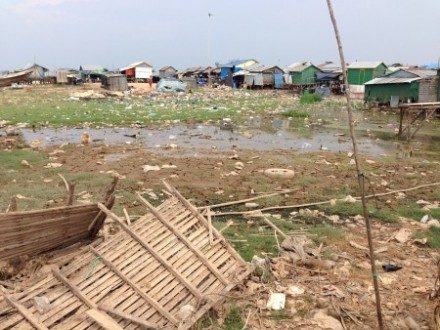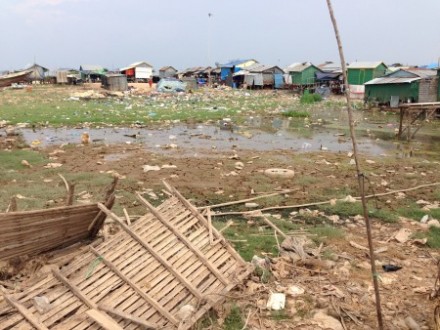
Livelihoods on the Tonle Sap lake are increasingly precarious. Photo: Sarah Milne
Thinking differently about environmental reform in Cambodia.
For the first time, Cambodia appears to have a home-grown environmental movement.
The local NGO, Mother Nature, with its young urban following, has certainly ruffled the feathers of the Cambodian People’s Party (CPP). With over 175,000 Facebook followers, the group has been able to stage remarkably public and effective direct action against tycoon-backed illegal sand dredging in the rivers of Koh Kong, and the dubious Areng dam in the Cardamom Mountains.
Driven largely by local community members, who in essence are fighting for their homelands, Mother Nature’s activists are now under attack from the ruling party. Their charismatic Khmer-speaking foreign spokesman was deported from Cambodia in February 2015, after direct orders from Prime Minister Hun Sen.
Now, the four most prominent local activists associated with the group have been arrested and jailed in Koh Kong. The cases against these young Khmer men are without doubt politically motivated. But prospects for their release are uncertain, especially as Cambodia’s “culture of dialogue” deteriorates at the national level.
In such a political environment, donors and NGOs must think hard about their interventions. They must ask: are we really helping? What should we do differently?
We address these questions here, with reference to key insights from our recent edited book, Conservation and development in Cambodia: Exploring frontiers of change in nature, state and society. The book synthesises contributions from 15 authors, who over the last decade have studied Cambodia’s multifaceted environment-development relationship.
The result is Cambodia’s first solid dose of political ecology – an approach that enables scholars and practitioners to engage critically with the environmental and political dimensions of change. Understanding change in a nuanced way is important: our book builds upon Polanyi’s notion of transformation wrought by capitalism (1944), responding in turn to Hughes and Un’s edited volume Cambodia’s economic transformation (2011) that documented the war-torn socialist country’s transition to liberalisation and growth.
Thus we ask: what are the environmental effects of Cambodia’s transformation?
Our book begins by conveying just how much is at stake here, both for people and nature. Cambodia currently sports the third highest national deforestation rate globally (Hansen et al 2013), predominantly due to agribusiness concessions cashing in on the illegal clearance of natural forest.
The construction of dams, such as the massive Lower Sesan II and multiple smaller dams in the Cardamom Mountains, now threatens the country’s water and fisheries resources, not to mention the livelihoods of thousands of villagers who face dispossession and displacement.
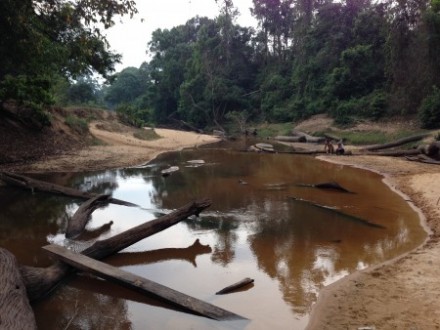
Site of the proposed Areng River dam, which local indigenous villagers and NGO Mother Nature have been resisting. Photo: Sarah Milne
As a consequence, the country is facing profound environmental change and associated social challenges. For instance, the cumulative effect of disrupted fish migration due to hydropower dams, deforestation of watersheds, loss of floodplain habitat, and over-fishing is expected to halve Cambodia’s national fish catch by 2030.
For the country with the highest per capita fish consumption in the Asia-Pacific, this represents a potentially catastrophic blow to local food security, and to socio-economic stability in general.
Faced with such challenges, it is essential to probe the role of the state in Cambodia’s natural resource management: does the government display political will and capacity to respond to the current situation? The CPP has initiated some responses since its 2013 election scare, including the installation of a new Environment Minister who is now spearheading efforts to harmonise national laws and regulations under a yet-to-be-released “environmental code”.
However the impact of such governmental efforts may be questionable in the light of harsh field realities, which pose a threat not only to activists, but also to well-intended local officials like NGO-backed park rangers – two of whom were murdered last month by illegal loggers.
Making sense of this dissonance between government rhetoric and reality requires us to move beyond typical understandings of state power and functionality, as we do in the book. In particular, we outline the significant role of natural resource rents in Cambodia’s post-conflict state formation, and in the maintenance of the current regime.
Critically, these resource rents are not necessarily formal or legal: rather, they tend to derive from illicit exploitation of commodities like timber, land, drugs, fish, squid, sand and more, which is either directly or indirectly enabled by the government.
For example, recent research suggests that multiple billions of dollars of hidden revenue are at play from illegal logging alone; and that this is just one among many streams of illicit finance that simultaneously service elites and prop up the state (Milne 2015). Under this system of rule and revenue generation, tycoons that benefit from CPP-awarded monopolies over natural resources repay the favour with gifts of public goods like roads, schools, offices, military equipment and government salaries.
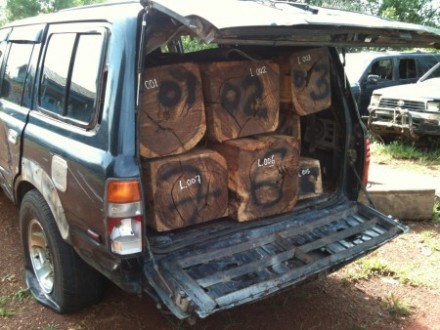
llegal logging of luxury timber is rampant in Cambodia’s protected forests. Photo: Sarah Milne.
Similarly, obligatory donations by elites to the party are spent on such things as the Party Working Group, the Cambodian Red Cross, and special initiatives like Order 01 for mass land-titling.
Such “off-budget” public spending may far exceed what is delivered through formal budgets; pointing to a strong nexus between state-making and illicit resource extraction. This unofficial yet prevailing political economy in turn poses major challenges for the state-centric approaches to environmental reform that are usually sought by donors.
For this reason, we suggest that reform must derive from a more holistic view of the relationships between nature and society, and be informed by a critical understanding of the drivers of Cambodia’s socio-ecological transformation.
The book’s first section illustrates the diversity and dynamism of this realm in contemporary Cambodia: Andy Roberts writes about the constantly changing livelihoods of those on the Tonle Sap floodplain, who live with nature’s cycles; Maylee Thavat considers the effects of introducing new high-yielding rice varieties to the lowland paddies of Prey Veng; Megan McInnes details how indigenous relationships with land are being ruptured by elite land grabbing; and Mike Sullivan discusses the implications of Chinese hydropower. Through this work we gain a detailed view of how the fabric of rural society in Cambodia is transforming, along with the ecosystems upon which people depend.
This scene-setting is vital, because it points to the inherent complexity of donor and NGO interventions that aim to tackle Cambodia’s significant environmental challenges – the theme of the book’s second section. Here, Richard Paley describes how effective protected area management is severely hindered by the Ministry of Environment’s patronage-based organisational culture.
Robin Biddulph then unravels the idealistic prospects of community forestry, in his study of an NGO-led project in Kratie that failed to account for field-level operational and political barriers. Finally, global conservation’s latest attempts to conserve forests through carbon markets are explored in a chapter on Cambodia’s two REDD+ pilot projects (where REDD+ stands for “reducing emissions from deforestation and forest degradation”). This chapter highlights a critical cross-cutting issue found in all environmental endeavours: that of conflicting agendas and policies within government.
For example, where REDD+ projects are being pursued, so too is planned deforestation through the allocation of Economic Land Concessions that overlay natural forest areas[1]. Thus we are reminded that, if interventions fail to acknowledge Cambodia’s underlying political economy and its associated processes of resource extraction, then they will likely face insurmountable challenges.
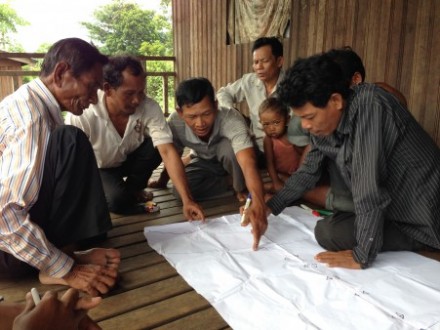
Indigenous villagers of Srei Chuuk commune in Mondulkiri discuss how the Vietnamese rubber company took their land. Photo: Sarah Milne
The book’s final section hints strongly that social movements can play a critical role in responding to environmental pressure, beyond the structures and exigencies of state or NGO interventions. To nurture this nascent trend, Jeremy Ironside calls for a paradigm shift among donors and NGOs, which would enshrine the role of local communities in managing land and resources. His argument highlights the danger of mainstream conservation thinking that sees protected areas as the only way to safeguard ecosystems.
Next, Margaret Slocombe reminds us that Khmer people are not passive actors, in her historical account of resistance to rubber plantations and colonial power, which has strong contemporary relevance. Demonstrating this, John Marston and Hoeur Chouen recount the story of a people’s resistance movement over irrigation reservoirs in the Tonle Sap floodplain. However their account provides a cautionary tale, as we learn how this “people’s” movement was absorbed into party politics.
Finally, Terry Parnell offers the hopeful story of the Prey Long People’s Network: while the network still struggles to define itself and to achieve lasting outcomes for forests, it stands as perhaps Cambodia’s first grassroots environmental force that captured the country’s political imagination. Indeed, what happened in Prey Long has clearly informed the strategy of Mother Nature in recent years.
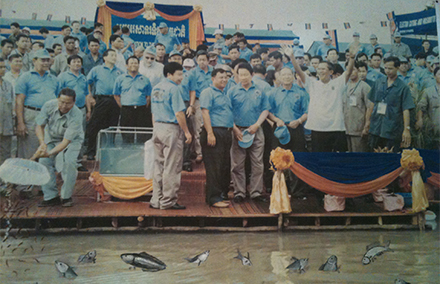
Politics and the environment are inseparable in Cambodia. Image from the Kompong Thom Fisheries Cantonment office. Credit: Sarah Milne
These examples of struggle and resistance signal how upheavals in nature-society are currently unfolding in Cambodia. The country’s growing social-environmental movement is now inseparable from the nation’s politics: it is spontaneous and uncontrollable, and calls into question the status quo of asymmetrical exploitation of Cambodia’s once-abundant natural resources.
Donors and NGOs have so far played a relatively small role in this movement, as they continue to remain aligned with government through the usual interventions of “capacity building” or “strengthening the rule of law”, or at best politically-neutral engagements with an outdated conception of civil society. And this, we argue, is what needs to change: while government-friendly engagement is necessary, this must be more nuanced, and it cannot be the only strategy on the table.
Thus we ask: what can Cambodia’s international development partners do instead?
They must keep step with the changing political landscape, recognising that there are now multiple nodes of power at play in Cambodia, and that there are emerging cracks in the incumbent extractive regime. New strategies must therefore recognise the sources and significance of these shifts.
While it remains important to lend support to change agents within government, donors and NGOs should also work to legitimise and encourage social movements in Cambodia that are trying to challenge ongoing resource depletion and social injustice. This type of approach could also help to ease the pro- versus anti-government polarisation that so often hampers environmental reform efforts.
Broadly, this is a matter of creating a new political space, in which donors and NGOs can take more risks. Risks entail occasional failures, but the time has come for development partners to dare to engage in difficult debates, and to build alliances across political boundaries.
Sarah Milne is a research fellow and Sango Mahanty an Australia Research Council future fellow in the Crawford School of Public Policy, the Australian National University. Their co-edited book, ‘Conservation and Development in Cambodia’, is available from Routledge.
Notes
[1] For instance, two concessions have recently wiped out 15,000 hectares of evergreen rainforest in and around the Seima REDD+ project, displacing hundreds of local indigenous families. See https://www.cambodiadaily.com/news/police-burn-down-mondolkiri-minority-communitys-shelters-81153/ and Milne 2015.
References
Hansen, M., P. Potapov, R. Moore, M. Hancher, S. Turubanova, A. Tyukavina, D. Thau, S. Stehman, S. Goetz, T. Loveland, A. Kommareddy, A. Egorov, L. Chini, C. Justice and J. Townshend. 2013. High-Resolution Global Maps of 21st-Century Forest Cover Change. Science 342 (6160): 850-853.
Hughes, C. and K. Un. 2011. Cambodia’s economic transformation. Copenhagen: NIAS Press.
Milne, S. 2015. Cambodia’s unofficial regime of extraction: Illicit logging in the shadow of transnational governance and investment. Critical Asian Studies 47 (2): 200-228.
Polanyi, K. 1944. The great transformation: The political and economic origins of our time. Boston: Beacon Press.
 Facebook
Facebook  Twitter
Twitter  Soundcloud
Soundcloud  Youtube
Youtube  Rss
Rss 